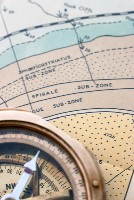Fascinating Facts About Explorers
History Trivia One of the earliest peoples to explore the Mediterranean area for trade purposes were the Phoenicians-expert shipbuilders.
One of the earliest peoples to explore the Mediterranean area for trade purposes were the Phoenicians-expert shipbuilders.
Between 1100 B.C. and 700 B.C. the Phoenicians had explored the entire Mediterranean; they even sailed into the Atlantic Ocean through the Strait of Gibraltar.
The Egyptian began to build wooden ships after 2700 B.C. for trading with neighboring countries along the Mediterranean coast.
Egyptians also traded far down the Red Sea along the coast of eastern Africa; Punt was a favorite trading partner where Egyptians could obtain frankincense, myrrh, ebony and ivory.
The era of Alexander the Great saw exploration by the Greeks into Central Asia and as far away as India.
Although the Vikings are known as sea raiders, they also are famous for their exploration forays. Leif Erikson is said to have been the first European to reach the New World at Newfoundland.
Polynesians began to travel in sea-worthy canoes from island to island in the South Pacific at the same time Phoenicians explored the Mediterranean.
Marco Polo journeyed to China in 1271 to serve in the court of emperor Kublai Khan; he is famous for the accounts of his travels.
Henry the Navigator, Prince Henry of Portugal, explored the west coast of Africa reaching as far as Sierra Leone, but he also financed many voyages of further exploration.
Explorers, travelers and merchants took the famous Silk Road to trade with the east between 500 B.C. and 1650; its route was punctuated by danger from bandits forcing traders to seek a new route the spice islands and China.
Vasco da Gama was the first to sail around the southern tip of Africa (the Cape of Good Hope) in 1497 forging a new route to the east.
The Chinese sent explorer Cheng Ho in a junk to explore India and East Asia between 1404 and 1433; some such junks (Chinese ships) made it as far away as Australia.
Timbuktu, a town located just south of the Sahara Desert was used as a base for explorers to travel to inland Africa.
Christopher Columbus is given the credit for discovering America, the New World, in 1492. His voyages were financed by Ferdinand and Isabella of Spain.
Columbus made four voyages to the New World; he mainly explored the islands of the West Indies, but he did reach the mainland near Panama on his third trip.
Ibn Battuta was a famous Arab explorer who wrote about his travels throughout the Muslim world; it is believed he traveled somewhere around 120,000 miles.
Ferdinand Magellan was the first explorer to sail around the world; of the five ships that began the trip, only the Victoria lasted the entire three-year journey.
Swedish explorer Sven Hedin is famous for his exploration and maps of central Asia done between 1890 and 1934.
Explorers relied on a variety of tools to find their way along their travels including the: sextant, astrolabe, compass, telescope, lodestone and cross-staff.
Much world exploration was done for financial reasons; the Spanish conquistadors are famous for discover and exploring new lands, but also then conquering those lands for gold and other riches.
Hernando de Soto was a Spanish conquistador who traveled through Florida in 1539 and tortured various Indians he met in order to find out where they hid their gold.
Francisco Coronado was another Spanish conquistador searching for gold in the American southwest; he discovered the Grand Canyon.
While he was exploring the New World in search of a Northwest Passage in 1610, Henry Hudson faced the mutiny of his men; he was set adrift with eight others, but none were heard from again.
Abel Tasman was a Dutch explorer who sailed around the southern coast of Australia to discover Fiji and New Zealand during the seventeenth century.
Captain Cook is famous for charting the eastern coast of Australia and New Zealand. He discovered the Hawaiian Islands in 1776 and even explored the Alaskan coast as well as parts of Antarctica.
Matthew Flinders was an English Explorer who also traveled around the coast of Australia; he is credited with naming Australia’s Great Barrier Reef.
Robert Cavelier, Sieur de la Salle has the credit for exploring the Mississippi River and claiming it for France.
John Hanning Speake traveled to Lake Victoria in Africa to prove that the Nile River had its origin there.
Englishman, Sir Richard Burton traveled into Africa’s interior to Lake Tanganyika; he also explored southern Asia and East Africa.
Famous for his African exploration, David Livingstone once had his boat overturned by a hippopotamus.
Mary Kingsley was a Victorian woman who traveled to West Africa to explore the region for new animals.
President Jefferson sent Meriweather Lewis and William Clarke to explore the vast territories of the Louisiana Purchase; they were famously guided by Sacajawea, an Indian woman, for part of their westward trek.
U.S. Navy officer Robert Peary reached the North Pole in 1909.
